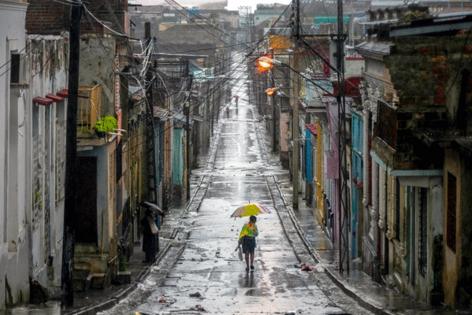Hurricane Melissa washes over Cuba, bringing flooding and power outages
Published in News & Features
Hurricane Melissa barreled over eastern Cuba on Wednesday as a powerful Category 3 storm, bringing torrential rainfall and heavy flooding to the eastern provinces after making landfall near Santiago de Cuba, the island’s second-largest city.
Although the government had not yet been able to assess the damage hours after the storm left the island Wednesday, images of destroyed houses, downed power lines and trees, and entire flooded towns showed the devastation that the powerful hurricane brought to the already impoverished region.
In eastern Cuba, electricity had been cut off since Tuesday and flights and transportation services remained suspended. The entire province of Guantánamo has no phone service, ETECSA, the state telecommunications company, said. The company also reported service disruptions in Santiago de Cuba and Holguín. It said it was working to repair an optical-fiber cable to reestablish communications with several affected municipalities in the province of Granma.
The hurricane’s center struck near the coastal town of Chivirico in the municipality of Guamá, Santiago de Cuba province, at 3:05 a.m. local time, Cuba’s Institute of Meteorology reported. Chivirico is about 40 miles southeast of Santiago de Cuba, the island’s second largest city.
Though Melissa weakened slightly after barreling over Jamaica, it remained an extremely dangerous storm. At landfall, the hurricane had maximum sustained winds of 121 miles per hour, according to Cuba’s Institute of Meteorology. It left the island as a Cat 2 hurricane near Banes, in Holguín’s coast.
Its center crossed through several towns in Santiago de Cuba province, including Palma Soriano and Contramaestre, and the province of Holguín, where it came near Birán — the birthplace of Fidel and Raúl Castro — Mayarí and Banes. It also wrecked the town of El Cobre, the site of the Basilica of Our Lady of Charity, a pilgrimage Catholic site that honors Cuba’s patron saint.
Images shared by the Shrine of our Lady of Charity in Miami show damage to the church’s roof, windows and gardens.
In the morning, images began circulating on social media of the devastation Melissa left behind.
Holguín reported more than 13 inches of rain, according to the Cuban meteorology institute, which caused severe flooding in the province’s main city and several towns. Sagua de Tánamo, a town in Holguín province, awoke to flooding of the Sagua River.
“The streets of Holguín are a raging river,” read the caption accompanying a photo published in the Cuban state-run media outlet Cubanoticias, showing a wide, flooded avenue.
Jiguaní and Bayamo, in the province of Granma, and Banes and Cueto, in Holguín, also reported heavy flooding.
“Thank you, Lord, that we are alive,” a resident is heard in a video showing the flooding in Jiguaní. “Look at my house,” a woman says in the video, pointing at her flooded home.
Eastern Cuba is one of the poorest regions in the country, where many people live in precarious housing with zinc roofs. In Palma Soriano, San Germán, Banes, Baire and Contramaestre, images posted by residents, local journalists and state media showed houses that had lost their roofs or were destroyed. In Contramaestre, a town in Santiago de Cuba province, Melissa’s strong winds uprooted trees and tore off sections of sidewalk.
“Extensive damage, and Hurricane Melissa is still over Cuban territory,” wrote Cuban leader Miguel Díaz-Canel on his Twitter account. “I ask our people not to let their guard down, to maintain discipline and to remain safely indoors. As soon as conditions allow, we will begin the recovery. We are ready.”
Strong swells with waves between 13 and 20 feet have been battering the southern coasts of Granma, Santiago de Cuba, and Guantánamo provinces, according to the Institute. The National Hurricane Center reported that peak storm surge could reach 7 to 11 feet above normal tide levels near and to the east of where the center made landfall, accompanied by large and destructive waves.
Cuban authorities said that more than 735,000 people had been evacuated, most of them with relatives and neighbors. In a televised message, the country’s leader Miguel Díaz-Canel urged the population to follow instructions.
“There must be good citizen behavior, creating an atmosphere of solidarity, cooperation, and respect for the measures that have been implemented so that we do not have to lament, firstly, the loss of human lives, and secondly, that the impacts and material damages can be mitigated,” he said.
_____
(El Nuevo Herald reporter Maykel González contributed.)
_____
©2025 Miami Herald. Visit miamiherald.com. Distributed by Tribune Content Agency, LLC.







Comments